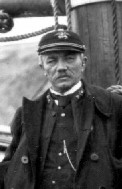Captain Michael A. Healy, USRCS
1839-1904
-
 Photo Gallery
Photo Gallery - Biographical Highlights
- Article: "Portrait"
- Article: "Hell-Roaring"
- Article: "Two Standards"
- Attack on Angoon, 1882
- Corwin Cruise Report, 1884
- Corwin Cruise Report, 1885
Revenue Captain Michael A. Healy, commanding officer of the cutters Chandler, Corwin, Bear, McCulloch and Thetis, became a legend enforcing federal law along Alaska's 20,000 mile coastline. In addition to being a friend to missionaries and scientists, he was a rescuer of whalers, natives, shipwrecked sailors, and destitute miners.
Captain
Michael A. Healy, USRCS, was born near Macon, Georgia in 1839. He was the
fifth of ten children born to Michael Morris Healy, an Irish plantation
owner, and his wife Mary Elisa Smith, a former slave. This family produced a
number of distinguished individuals. Three brothers entered the priesthood;
James became the first black bishop in North America, Patrick was president
of Georgetown University, and Sherwood became an expert in canon law. Three
sisters became nuns, one reaching the level of mother superior.
Michael Healy was uninterested in academic pursuits and so began a seagoing
career as a cabin boy aboard the American East Indian Clipper Jumna
in 1854. He quickly became an expert seaman and rose to the rank of officer
on merchant vessels.
In 1864 he applied for a commission in the U.S. Revenue Marine and was
accepted as a Third Lieutenant, his commission being signed by President
Abraham Lincoln. After serving successfully on several cutters along
the east coast, he began his lengthy service in Alaskan waters in 1875 as
the second officer on the cutter Rush. He was given command of
the revenue cutter Chandler in 1877. Promoted to Captain in March
1883, he was given command of the cutter Thomas Corwin in 1880. In 1884 he and the Corwin participated in a controversial
bombardment of the native
village of Angoon at the request of an officer of the U.S. Navy on
patrol in the area.
In 1886 he took command of the
cutter Bear. Although already held in high regard as a seaman
and navigator in the waters of Alaska, it was as commanding officer of Bear
that Healy truly made his mark in history. During the last two decades of
the 19th Century, Captain Healy was the United States Government in most of
Alaska. In his twenty years of service between San Francisco and Point
Barrow, he acted as: judge, doctor, and policemen to Alaskan natives,
merchant seamen and whaling crews.
He operated in an eerie echo of what would become the mission of his Coast
Guard successors a century later: protecting the natural resources of the
region, suppressing illegal trade, resupply of remote outposts, enforcement
of the law, and search and rescue. Even in the early days of Arctic
operations, science was an important part of the mission. Renowned
naturalist John Muir made a number of voyages with Healy during the 1880s as
part of an ambitious scientific program. With the reduction in the seal and
whale populations, he introduced reindeer from Siberia to Alaska to provide
food, clothing and other necessities for the native peoples.
The primary instrument in Healy's capable hands, to accomplish all of this,
was the cutter Bear, probably the most famous ship in the history of
the Coast Guard. Under "Hell Roaring Mike", Bear became
legendary as "Healy's Fire Canoe". Healy and Bear proved to
be a perfect match, a marriage of vessel capability and unrivaled ice
seamanship that became legend. He served as her commanding officer
until 1895.
During that time he became something of a celebrity. A January 1894 article in the New York Sun described him thusly:
"Capt. Mike Healy is a good deal more distinguished person in the waters of the far Northwest than any president of the United States or any potentate of Europe has yet become. He stands for law and order in many thousands of land and water, and if you should ask in the Arctic Sea, 'Who is the greatest man in America?' the instant answer would be 'Why, Mike Healy.' When an innocent citizen of the Atlantic coast once asked on the Pacific who Mike Healy was, the answer came, 'Why, he’s the United States. He holds in these parts a power of attorney for the whole country.'"
Healy was "on the beach" for four years following a controversial court-martial conviction for gross irresponsibility and "scandalous conduct," however, in 1900, due in part to a need for more cutters in Alaskan waters following the Alaska gold rush, Healy was placed in command of the cutter McCulloch. His last two years of sailing in Alaskan waters were aboard the cutter Thetis. Captain Healy retired in 1904 at the mandatory retirement age of 64 and died one year later.
Other Healy Material:
-
Biographical "Highlights" of Michael A. Healy's Life & Career
-
"Hell-Roaring Mike Healy"; an article by James "Jack" O'Dell.
-
"Two Standards of Judgment"; an article by Professor John F. Murphy of the Coast Guard Academy regarding Captain Healy's 1890 court-martial.
-
"Portrait of Captain Michael A. Healy"; a series of three articles on Captain Healy by Professor John F. Murphy and Professor Paul H. Johnson, both from the Coast Guard Academy.
- Report of the Cruise of the Revenue Marine Steamer CORWIN in the Arctic Ocean in the Year 1884, by Captain M. A. Healy, U.S.R.M. Provided courtesy of Google Books (pdf)
- Report of the Cruise of the Revenue Marine Steamer CORWIN in the Arctic Ocean in the Year 1885, by Captain M. A. Healy, U.S.R.M. Provided courtesy of Google Books (pdf)
- The Cruise of the Corwin, a book by John Muir, published in 1917. Provided courtesy of Google Books (pdf).


